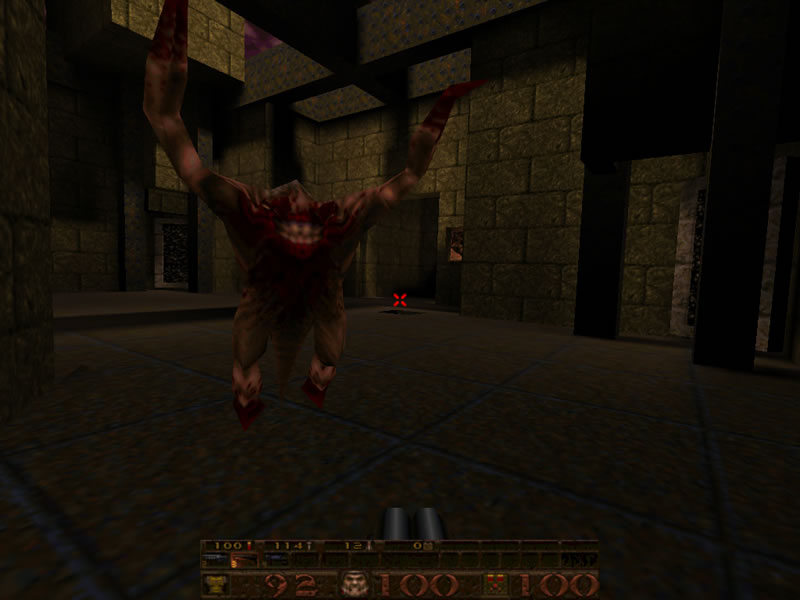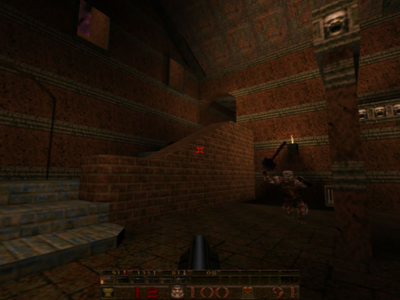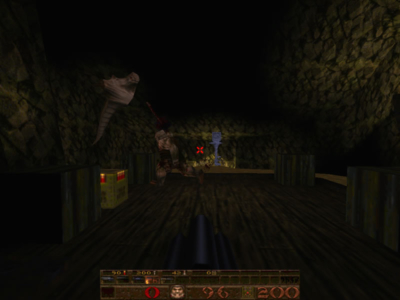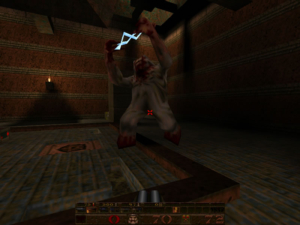
Quake
Written by: Stoo
Date posted: November 18, 2007
- Genre: Action
- Developed by: id sofware
- Published by: GT Interactive
- Year released: 1996
- Our score: 6
I think it’s fair to say that on this site we rarely make any really outrageous claims outside of mainstream thought. We might weigh in on questions that have proved divisive amongst gamers, like “Is Morrowind an amazingly immersive free-form fantasy experience, or an empty soulless husk of a game?” However, we don’t often venture forth with a minority opinion that we believe challenges conventionally held wisdom. About the only good example I can think of is Rik’s claim that Sensible Soccer – remembered with much love by former Amiga gamers – was in fact heavily over-rated and a bit dull. Maybe our conformist nature is because we’re just mindless sheep, or maybe if most gamers feel a certain way then there’s probably a good reason for it, I’m not sure.
One case where I used to think we might rock the boat however – as much as any tiny minnow in the world of gaming sites could, ie: not a lot – is Quake. Generally regarded as one of the major milestones in the evolution of first-person shooters, it received glowing reviews all round (96%, “fucking brilliant” said PC Zone) and gained mass popularity. It’s greatest rival was Duke Nukem 3D, but while that put up a spirited challenge, 3D Realms’ offering was perhaps the last hurrah for an old generation. The consensus was that with Quake a new generation had arrived. Yet I was never all that impressed. The mental keywords I had filed away for this game were “formulaic”, “uninspiring” and “brown”. Especially brown. I played the shareware version, shrugged and never revisited the game. I don’t think it ever made much impact on Rik either.
However I’ve recently shelled out for the iD Super Pack on steam – a package containing nearly all of their back catalogue. I started with Wolfenstein 3D – a logical place for charting the history of the genre, as it’s generally regarded as the game that established shooters as we know them. From there I suppose the next logical step would have been the Doom generation. Except, well, we’re never quite that organized around here. Instead I found myself quite eager to give Quake and its sequel (which I never played at all) fair appraisals.
Let’s start with the 3D engine powering the game. I think it’s fair to say, this is one area where important advances were made. By the mid-90s iD had already established themselves as the single most important driving force behind the development of the genre, and in particular the development of the graphics engines that made it possible. Wolfenstein 3D and it’s monumentally successful follow-up Doom set the ball rolling using a trick called raycasting – which isn’t really “proper” 3D at all. Rather, it allowed something that could create sort-of-3D interior environments, and could run at a decent speed on the hardware of the day. Wolfenstein 3D had completely flat levels, Doom added the concept of “up and down” by allowing height information for each point on the floor map. It still had significant restrictions though; for example it couldn’t produce one room directly above another. Also, enemies in these games were represented by 2D sprites – the engine picking a suitable image from a list based on the player’s viewing angle.
Quake however is a truly 3D affair, building its environments out of polygons in three-dimensional space. Without having to resort to tricks or approximations, this approach allows for more realistic environments. For example, a tower with several floors – a simple idea, but impossible in Doom. Or a bridge over a chasm – the only way that could have been done before was a solid block splitting the chasm in two and extending as far down as its floor. Also with the true 3D came “proper” tilting of the player view up and down; earlier games often had to skew your view in a strange way to try and fake the effect. On a related note, Quake was the game that introduced the mouse-based control system we normally use today. In short, the technology was for the most part a big leap over anything we’d seen before.
A clever engine doesn’t necessarily mean interesting environments though. My memories of Quake were of a kind of dull brown monotony; brown castles with brown corridors and brown caves. In fact, sitting down to play the game, that’s not fair. It’s more a sludgy grey-green. With some parts in rusty-red or dark grey for variety. Seriously tho sometimes Quake does do a credible job of some gloomy, moody locations; dimly lit bleak-looking fortresses beneath unworldly skies. There are just rather a lot of those samey dull corridors too. A year or so down the Raven would to a better job of showing off the engine in Hexen 2.
As for the enemies, they’re also constructed of polygons. Descent beat it to the punch on this count, but then that one was populated with robots built from blocks and wedges. I think it’s fair to say that Quake’s articulated humanoid figures, even though fairly basic and low-poly compared to their modern peers, are an achievement over and above blockbot. They are again rather brown; however, I can’t deny that they feel a fundamental step more realistic than the flat blurry sprites of before. The scrags – floating worm-things are rather pathetic, and the shuffling zombies just annoying. The brutal ogres with grenade launchers and chainsaws are more impressive however. Even better the clawed, leaping fiends are enough to send you running in a cowardly fashion. And the mighty shambler tends to provoke “oh, shit” moments of running backward holding down the fire button.
You can at least count on some impressive guns to tackle these monsters too, tho. At the heart of the arsenal are nailguns – both a regular and a faster-firing version. In practice they’re basically just machineguns, but there’s something thematically suitable about pumping a monster full of metal spikes instead of just regular little bullets. The grenade launcher is fun too – grenades will bounce around for a while before going off, so it allows you to hit targets out of you line of sight. The rocket launcher tho is if anything rather overpowered, with a high rate of fire and a 50-shot capacity.
Beyond shooting ogres in the head, though, there’s not a lot to talk about. These were the days after all when the standard pattern was to dash around a map shooting monsters, searching for keys and ultimately the exit. Within the pattern, Quake certainly does competently. It’s fast, it’s fluid and the combat is well-tuned. There are some great moments of frantically whirling about, diving behind cover, opening fire on anything that so much as twitches, and bouncing grenades around corners. It never really reaches for much beyond that, though. Also there’s no story to lend any kind of weight to proceedings, beyond a few token paragraphs about teleportation or something.
So then, any particularly controversial conclusions? I came to this largely expecting to write “boring, brown, yawn” but I did enjoy Quake one step more than that. Maybe I’m getting soft in my old age? There definitely are some moments when you cut down Ogres in a hail of nailgun fire, that do feel like some quality adrenaline-pumping action. Also, watching that fully-3D ogre keel over with a moan is a clear step more realistic than the sprites of before. Things leap, bounce and explode with a convincing feel that the earlier generations lacked.
Still I’m feeling a little ambiguous in my reaction here. My own bias in first-person games is towards those that try to be more immersive – through story, environment, ambience or just some good ideas. Okay, you might say that’s an unfair demand to make of a ten-year-old shooter. Still, System Shock had made a worthy attempt at being more involving, and that’s even older. Meanwhile Hexen at least had a bit of puzzle-solving. Also, if this game was supposed to be the “next big thing” in its day, you might ask if to warrant the abundant praise it should have tried to do things Doom hadn’t already, beyond just technical advances. Again too, those particular advances are themselves marred a little by the pervasive sense of brown.
Still Quake accomplishes much of what iD had aimed for. The last shooter of this vintage that I played was Powerslave – and it’s clear this represented a clear upgrade from that old 2.5D generation, even if not a revolution in gameplay terms. The quality here does still show, a decade on. So basically if you want to shoot monsters after work, Quake still delivers. It’s peanuts on Steam and will serve you just as well as many much newer games. It just doesn’t earn the kind of special recognition from myself that a few other oldies do.
So I guess I wimped out of being really controversial this time. Maybe one day I’ll write about why I hated Operation Flashpoint so much…





 Posts
Posts